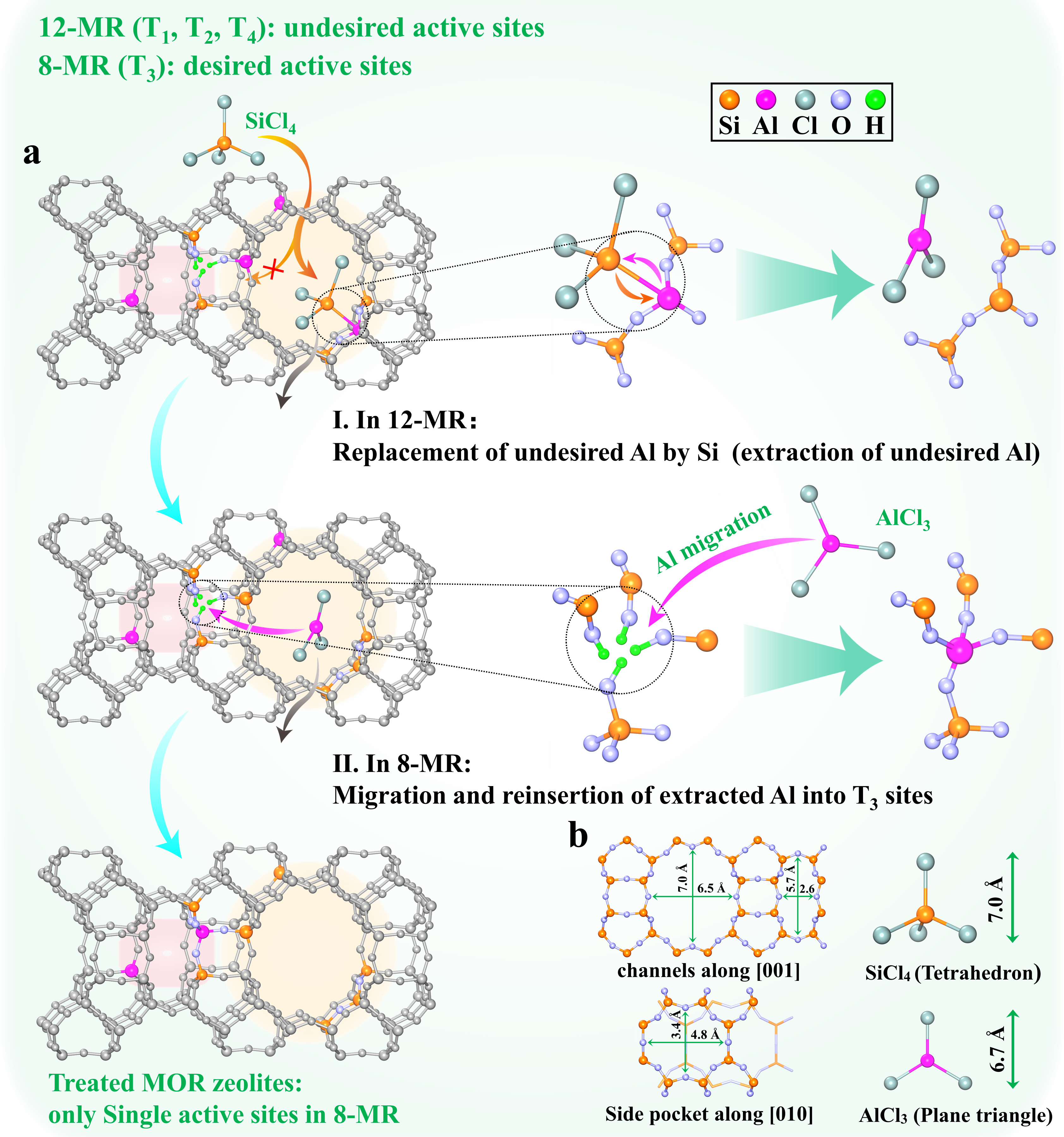Catalysis research always pursues more efficient catalysts and realizes selectivity-controlled conversion. Zeolites have been widely applied in adsorption separation, ion exchange, and heterogeneous catalysis.The location of acidity-related aluminum atoms in the zeolite framework has a significant influence on the physicochemical performances of the zeolite. Therefore, understanding and further controlling the location of framework Al are of critical importance, being a common interesting matter for establishing zeolite structure-performance relationships and for rational catalyst design.
Recently, the research team led by Prof. LIU Zhongmin reports a strategy to preferentially relocate mordenite (MOR) framework Al atoms into the desired T3sites by a low-pressure SiCl4treatment (LPST). The treated MOR catalysts have excellent catalytic performance on the dimethyl ether (DME) carbonylation to methyl acetate (MA) reaction, whichis a meaningful new way for transforming C1feedstock to C2oxygenates, and the reaction itself is very interesting for its high sensitivity to BASs positions in MOR zeolite.

In this work, we could draw an entire picture of the change of framework compositions for the samples before and after LPST, for further inferring the treated reaction networks along with the evolution of framework compositions, including three stages: I) Al extraction stage. Due to the restriction of molecular size, SiCl4(7.0 Å, tetrahedron configuration) can selectively access 12-MR (7.0 × 6.5 Å) rather than 8-MR (5.7 × 2.6 Å) channels. As SiCl4molecules diffuse into the 12-MR, they preferentially react with the framework Al in 12-MR with the release of AlCl3. That is to say, the undesired framework Al is extracted as a form of AlCl3via replacing by Si. II) Al migration stage. The AlCl3(6.7 Å) molecule, which is more easily distorted owing to its plane triangle configuration, can migrate into 8-MR channels through the side pockets (4.8 × 3.4 Å). III) Al Insertion. The AlCl3could react with silanol defects of 8-MR channels to insert Al into T3sites as tetrahedrally coordinated species.
High-field27Al NMR was used to identify the exact location of framework Al for the MOR samples. The results indicate that 73% of the framework Al atoms were at the T3sites after LPST under optimal conditions, originates reactively favorable active sites (about 90%) in 8-MR channels, which leads to controllably generating and intensifying active sites in MOR zeolite for dimethyl ether (DME) carbonylation reaction with higher methyl acetate (MA) selectivity and much longer lifetime (25 times).
This work puts forward a facile strategy for directionally relocating framework Al among the different T-sites of the MOR zeolite and potentially applicating it in other zeolites to control Al location.
This result, entitled “Increasing the Number of Aluminum Atoms in T3Sites of a Mordenite Zeolite by a Low-pressure SiCl4Treatment to Catalyze Dimethyl Ether Carbonylation”, was published onAngew. Chem. Int. Ed.(DOI: 10.1002/anie.202116990). This work was supported by the National Natural Science Foundation of China, the International Partnership Program of Chinese Academy of Sciences, the Key Research Program of Frontier Sciences, Chinese Academy of Sciences. (Text and picture by LIU Rongsheng)
Increasing the Number of Aluminum Atoms in T3 Sites of a Mordenite Zeolite by a Low-pressure SiCl4 Treatment to Catalyze Dimethyl Ether Carbonylation. Rongsheng Liu,Benhan Fan,Wenna Zhang,Linying Wang,Liang Qi,Yingli Wang,Shutao Xu,Zhengxi Yu*,Yingxu Wei,Zhongmin Liu*,Angewandte Chemie International Edition,e202116990,2022.